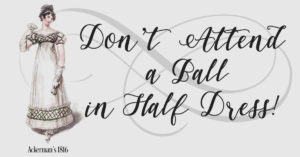A Well Dressed Gentleman

There’s just something about a well dressed gentleman in a cravat!
If you missed the first part of this series, you can find links at the bottom of this post.
As we talk about fashion and dress, it is easy to forget about the gentlemen. So let’s take a few moments to talk about their mode of dress.

Costume Parisien 1809 Half Dress
As with ladies, menswear also had categories of Undress, Half Dress and Full Dress. Undress meant informal, comfy clothes worn at home around the family circle. In undress, a man might take off his cravat. Trousers and waistcoats and coats with less formal cuts and fabrics would be part of this sort of wear. Undress did not mean going without a coat, waistcoat or shirt. That would simply not be done. (Just a side note, my guys would probably die if they could not take off their shirts the moment they walked in the door. Sometimes they don’t even make it out of the front hall before shirts and socks go flying…)
Half Dress for Gentlemen
Half Dress included all the clothes of everyday life outside the home. A rough modern equivalent would be anything from business casual to suit-and-tie type clothing. Breeches and the skin-tight long pantaloons could be worn for Hall Dress. By 1810, trousers joined the ranks of Half Dress. Fabrics would be nicer than undress and better tailored. Cravats of simpler fabrics were worn, tied with plainer knots. Practical boots of a variety of styles prevailed during the day.
Unlike ladies’ wear, men’ wear was not embellished with fancy trims or embroidery. Instead quality fabrics and craftsmanship would set garments apart. Even buttons were understated, with day wear sporting self-covered or other discreet buttons. Unlike the earlier Georgian period, somber colors dominated menswear: dark blue, brown, black, grey, greens shade from dark to olive green, beige/cream and white.
A Gentleman’s Full Dress

Costume Parisien. 1813 Men’s dancing wear
Full Dress required breeches until about 1820 when pantaloons became acceptable for evening wear. Both garments were cut to fit very close to the body and show off a well-shaped leg. Silk breeches, usually of black or white, were especially fashionable and were worn with stockings long enough that no skin would show. White stockings were worn with white breeches, and black or white stockings with black breeches. Boots were not worn in Full Dress; they were the thing of day wear. For formal occasions, men wore dark pumps, or dancing slippers.
Cravats of fine linen or silk, tied in elaborate knots graced their neck, sometimes atop shirt frills. (Total aside here, but, what is it about a cravat that is so swoon-worthy? I’m lucky that my husband will dress up Regency with me for dance events and nothing looks so good on him as that tied white cravat!) Not much of the shirt would show in full dress, perhaps the cuff, with or without frills at the end of the coat sleeve, and a bit of the chest when cravat and waistcoat might not quite cover. But it would be made of fine, white fabric. The waistcoat started out being limited to black or white for evening wear. By 1820, waistcoats made with colored fabrics and embroidery became acceptable.
A tail coat, usually black, would be worn open to show both the cravat and waistcoat. Made of fine fabrics, tailors would cut it for a very close fit. Effectively it would pull the shoulders back and the back straight to help achieve the ideal silhouette. (If you’re thinking of a straitjacket here you wouldn’t be too far wrong.) Metal buttons, shiny but plain, might (but not always) be used on a man’s formal jacket, but never on his breeches. A hat and white or buff colored gloves would often finish the ensemble. (Gloves were worn at all times, except while eating.) Other than a possible watch fob, gentlemen generally wore no jewelry or other decoration.
Here’s a few examples of a Regency gentleman dressed for a night out. Images from Costume Parisian and Ackermann’s, Public Domain.

Wow, men had it as tough as women. Blessed is the man who had an excellent valet. And what a job that would entail. A valet would have to be knowledgeable in all forms of dress, keeping up with the latest men’s fashions, knowing how to treat and take care of all those fabrics and helping his man look the best possible in the eyes of a fickle and everchanging society. Man, that is one tough job. I noticed all the pictures are of a tall statuesque figure. I can see why Darcy, and yes, Wickham too, would look amazing in the fashion plates displayed. This was an interesting post.
It is really easy to underestimate the role of the valet in the era!
Pingback:Ball Gowns: A Gallery of Finery ~ Random Bits of Fascination